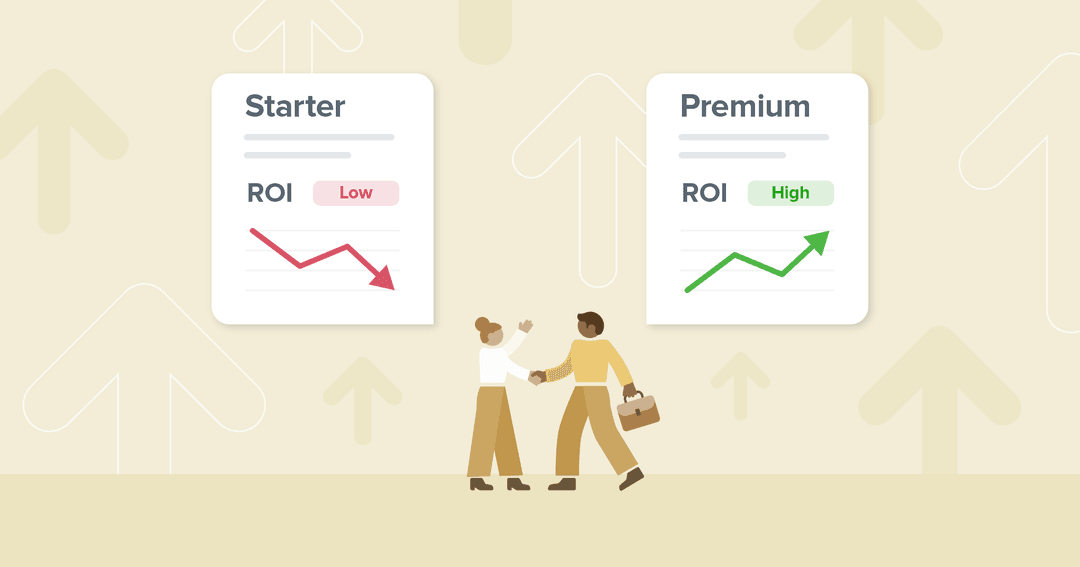Table of Contents
QUICK SUMMARY:
Upselling encourages clients to enhance their current services, tailoring solutions to their specific goals for sustained revenue growth and increased profitability. This strategy boosts agency income without the need for new client acquisition. In this article, you'll discover effective ways to elevate client investments for mutual success.
Mastering the art of upselling is the key differentiator between stagnant agencies and those experiencing rapid growth.
On paper, it may seem as simple as explaining the benefit of an add-on or a more expensive service to your client. However, strategic upselling is more complex than simply pitching and explaining.
Many moving parts are involved. Effective upselling isn’t just about selling in isolation (as the term suggests). It involves building agency-client relationships over time, understanding your clients’ evolving needs, and presenting your upselling pitch at the right time.
By creating an upsell strategy, marketing agencies distinguish themselves from competitors, understand existing customers better, and pave the way for sustainable growth.
What Is Upselling?
Upselling is a proactive approach that’s used to encourage existing clients to upgrade their current products or services. Upselling involves:
Evaluating your clients’ needs on a case-by-case basis
Suggesting services that align with their long-term objectives
Opening avenues for recurring revenue if those services are ongoing
Increasing overall profitability
Cross-Selling vs. Upselling: What’s the Difference?
Both upselling and cross-selling are techniques agencies use to increase revenue and maximize customer value. While they’re undoubtedly similar, there are distinct differences between them.
As outlined, upselling aims to persuade existing clients to take a more premium offering, increasing the overall sale value. For example, your agency may upsell an existing customer from a lower-tier one-off service to a more comprehensive, feature-rich package.
On the other hand, cross-selling involves pitching related products or services to your clients. With cross-selling, these suggested offerings may not always have the same value as the initial purchase.
For example, you may cross-sell basic social media management services to a client who has already purchased a higher tier of website development services.
Why Is Upselling Important for Marketing Agencies?
When you factor in the moving parts, upselling can provide a more significant ROI than attracting new clients (and with less effort).
According to the recent marketing agency benchmarks survey, client acquisition is the #1 challenge facing today’s agencies.

Think about all the work that goes into marketing, selling, and onboarding new clients in a month. It’s often a resource-heavy exercise that takes significant time to generate results.
On the contrary, consider how much effort goes into persuading existing clients to increase their PPC budgets or upgrade their accounts.
You’ve already built a rapport and know their needs intricately (especially if they’re legacy clients). That means less time figuring out the market and more time creating tailor-made solutions that address their specific needs.
The best part? Upselling isn’t only a way to increase sales and generate sustainable revenue. If your agency is skilled at delivering results, successful upselling will strengthen customer satisfaction and continue to demonstrate your agency’s value proposition.
That said, upselling is an art. Picking up the phone out of the blue and telling your client, “Hey, you should spend more money with us!” isn’t exactly a strategy.
So what’s the best course of action, then? Let’s delve into it further.
8 Upselling Techniques Your Agency Should Know
Here are eight proven upselling strategies to help you expand client accounts and grow your marketing agency.
1. Keep an Open Line of Communication
Long-lasting agency-client relationships go beyond executing campaigns and sending some email follow-ups sporadically. It boils down to continuous communication and relationship-building.
This approach is beneficial for upselling since it’s simple, low-hanging fruit. Having regular contact with your clients means:
Touching base about their current goals and needs
Determining whether they’re satisfied with your agency's services
Understanding their long-term objectives and upselling when opportunities arise
We schedule regular touchpoints with current customers to ensure that we’re meeting expectations, and we identify other ways to support business growth. As stewards of their marketing budgets, we prioritize communication, attentiveness, and results to maintain a healthy partnership.
Jason Willis, Creative Director, Social Firm
Active Listening Goes a Long Way
No need to be pushy or visit your client with brochures–adopt an active listening approach and show genuine interest in helping them along their journey. You may be surprised they’re already considering other services because of their trust in your agency.
As Jason Willis, Creative Director at Social Firm, goes on to describe, “Building trust through a consultative approach enhances the relationship and adds ongoing value that your existing customers will appreciate.”
“This trust will inevitably lead to upselling opportunities that will best serve your clients and increase revenues for your agency.”
2. Ease Clients Into Signing on for Additional Services
Many clients are hesitant to sign on for a more premium version of a retainer package. However, once they’ve tiptoed in and seen success, they’re more likely to say yes to your upsell offer.
Take this example. You’ve recently signed on a new client that’s looking to revamp their overall marketing strategy and boost conversions. They seem like a great candidate for your agency’s PPC services, but they were hesitant to dive in right away.
To ease them into the expenditure, you begin working on inbound marketing services like creating a consistent social media presence.
After some time, their engagement and conversion rates have steadily increased. They’re now much more confident in your agency (as expressed in your last monthly 1:1). You’re now in a better position to re-approach the topic of PPC services and upsell them successfully. This also works great when launching new services for your agency.
Remain Flexible and Offer Short-Term Incentives if Needed
Instead of upgrading immediately, offer short-term incentives that give clients a taste of what to expect.
For example, adding paid ad boosts and CTAs to the client’s top-performing social media posts for a month (or two) demonstrates how the strategy will bring new customers through the door.
This allows your client to see the potential ROAS and increases their chances of saying ‘yes’ to your long-term, relevant upsell.
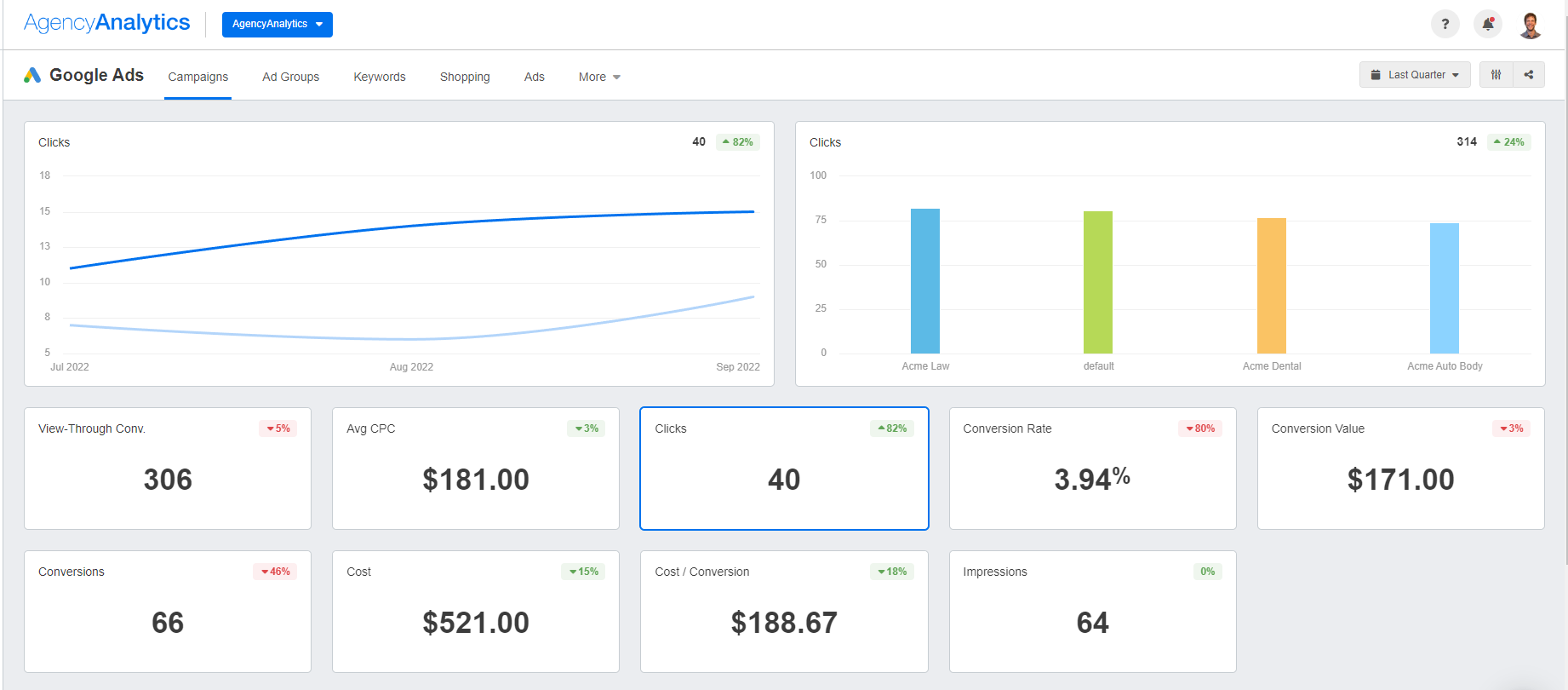
No need for fluff and second guesses. Showcase marketing ROI and upselling potential through live marketing dashboards–try it on AgencyAnalytics, free for 14 days.
3. Anticipate Your Clients’ Needs in Advance
When you know your client's long-term goals, it becomes much easier to pitch additional services because you already know what they’re after.
To keep on the pulse of evolving marketing needs, be sure to:
Map where your clients are in the customer journey since their needs have evolved since onboarding. For example, an e-commerce client may have initially prioritized brand awareness during their business launch. However, they may now be at a point where they want to increase their average order value and maximize sales.
Over time, customer preferences and the competitive landscape may change, both of which have an impact on the customer journey. By regularly revisiting the customer journey, we can proactively adapt to market shifts and offer opportunities that enhance our overall engagement with our clients while aligning with the needs of their existing customers.
Kerrie Luginbill, Chief Strategy Officer at OTM
Revisit your ideal customer profile (ICP), update it if necessary, and brainstorm marketing needs that may have been previously overlooked
Have dedicated resources that determine whether there are upselling opportunities to capitalize on
We have a client services team made up of senior strategists within the delivery and leadership teams who are specifically responsible for identifying growth opportunities on a quarterly basis. This involves keyword/topic identification, mapping gaps in their funnels, technical improvements, UX optimization, advertising opportunities, and ways to increase reach through different paid channels or tactics.
Matthew Taylor, Director at Common Ground
4. Demonstrate ROI and Reiterate Your Agency’s Track Record
Maintaining positive agency-client relationships is essential to successful upselling. Your agency must have a strategy to demonstrate historical performance and support why additional services are needed.
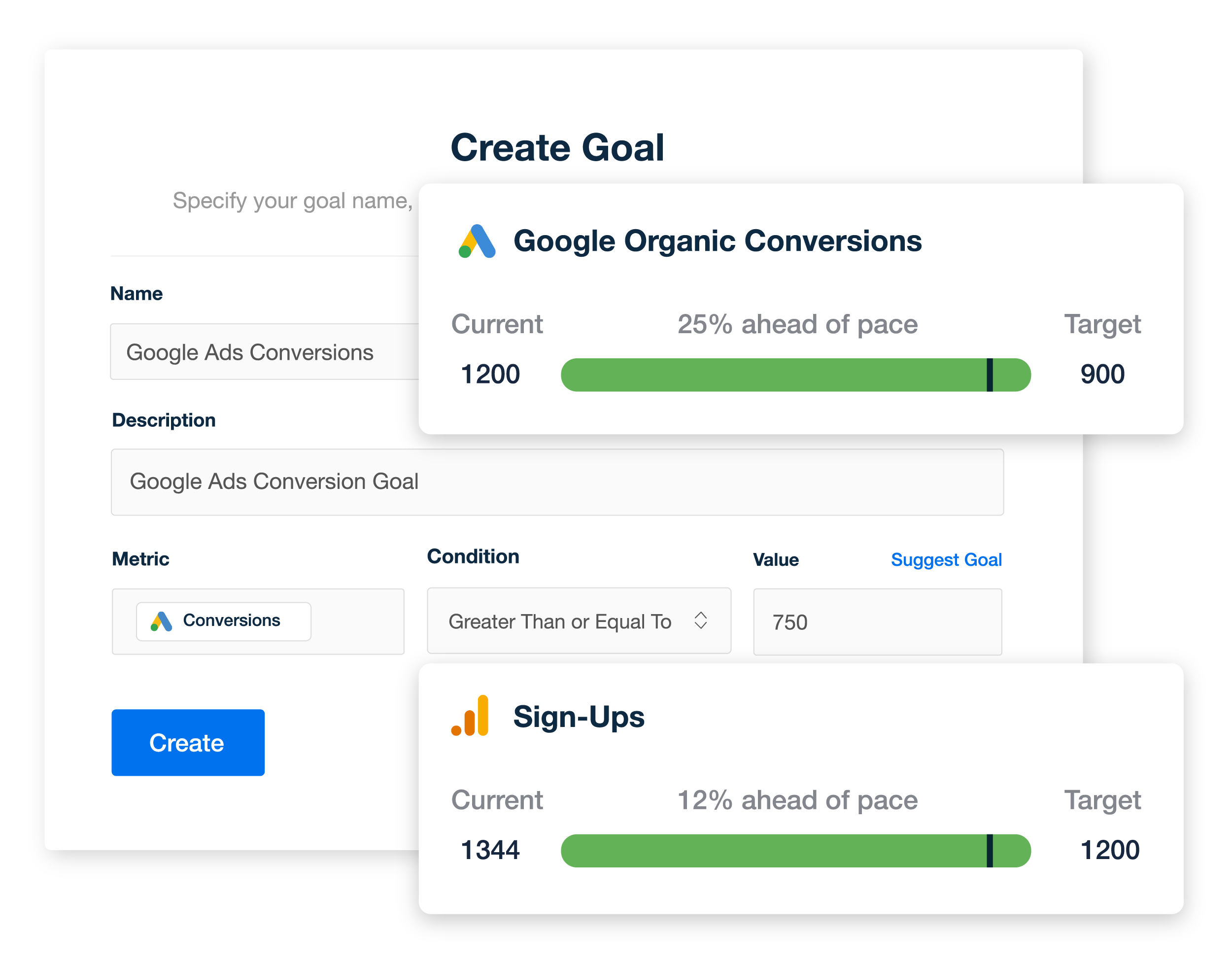
Use custom goal widgets to easily highlight how your agency is performing against critical targets.
Demonstrating value is especially important when you’re not directly working with C-suite executives or decision-makers.
While a social media manager may show interest in the nuances of marketing campaigns, upper management will want to see high-level results. After all, capital is involved, and the numbers must make sense from a business standpoint.
We prove ROI to existing customers through data in a monthly, quarterly, and annual reporting process. First, we create a set of objectives and corresponding key metrics for each service and then report against those metrics on an ongoing basis. We also require transparency, and we track business goals alongside our key metrics to ensure our efforts are aligned.
Kerrie Luginbill, Chief Strategy Officer at OTM
Demonstrate your track record and upselling potential ROI by:
Sharing customer success stories with proven results. Ideally, they should be related to whatever services you’re upselling
Getting testimonials from previous clients as social proof. Repurpose these insights on your social media pages, website, and other marketing collateral (e.g., sales pitch decks)
Using live marketing dashboards as presentation tools during an upselling pitch. This dynamic approach makes it easy to share real-time insights. In addition, it’s easier to showcase current campaign progress that validates your upselling recommendations
Packaging historical insights into a comprehensive marketing report. Use the executive summary section to highlight successes, share upselling recommendations, and how they tie into long-term goals
5. Upsell Services That Align With Your Clients’ Goals
Stay within what your clients are currently doing. Evaluate their current services and see if there’s an opportunity to upsell relevant services.
For example, let’s say you’ve developed a comprehensive SEO strategy for a client. Things have been steadily progressing for a few months, and overall they’re happy with your services.
As their brand grows, you’ve identified that they’re better suited to a more expensive version of a retainer package. This service upgrade includes more blog posts and regular SEO audits–precisely what they need to hit their organic traffic targets.
From there, package those recommendations into an SEO proposal and outline why it complements the client’s overall goals.
That way, you’re not upselling a product or service that is totally off the mark. While it’s at a higher price, it aligns with what your clients are trying to achieve.
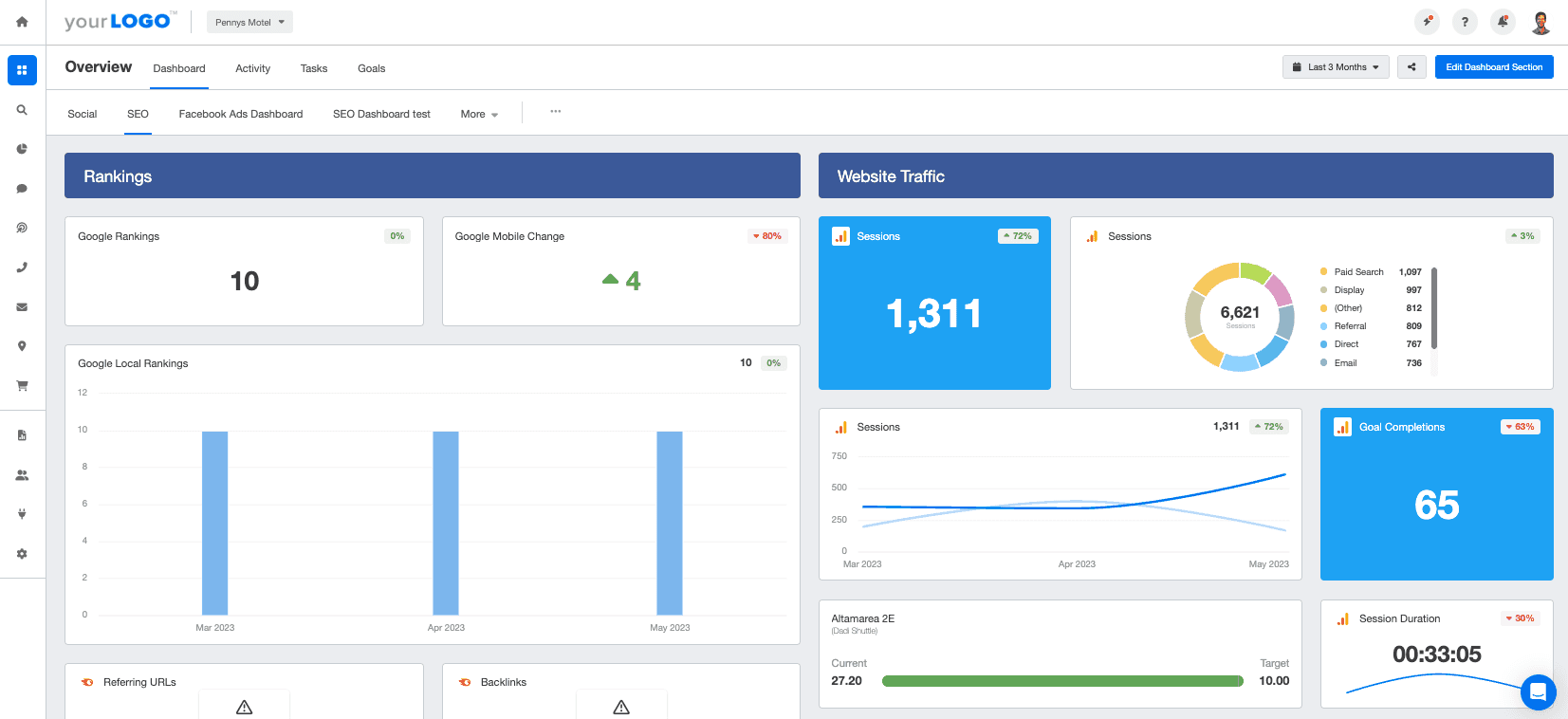
Create tailor-made proposals that clearly outline your upselling recommendations and why they’re needed. Explore pre-built templates on AgencyAnalytics. Sign up for a free 14-day trial today.
6. Make Sure the Client Needs Whatever You’re Upselling
The fastest way to lose the trust of loyal customers is to pitch them things they don’t need.
Upsell offers aren’t only about boosting sales for your agency but also about adding value for your clients. After all, the quick upselling wins aren’t worth it if your clients won’t actually benefit from those services.
To avoid any mishaps, be sure to:
Upsell relevant services that create the most impact for your clients
Only upsell services that are absolutely necessary for your clients to meet or exceed their goals. If you don't, then you will erode that relationship over time. Don't sell them fluff because they'll buy it, and neither of you will be better for it.
Jeremy LaDuke, Founder at Epic Nine
Adjust your upselling recommendations as needed (even if it means suggesting a lower-cost service or forgoing it altogether)
Listen to your clients. Be a steward of their marketing success and take a consultative approach to your relationship.
Jason Willis, Creative Director at Social Firm
Know when to take a step back. Even if you’ve got your client’s best interest in mind, sometimes they’re not ready to take up that upselling offer, or it’s not the best fit
Be agnostic. Sometimes your solution is not the best one. Be prepared to recommend a tool or solution that is different from your own that would best help the client succeed. They will never forget who recommended it if it works well.
Sagan Medvec, Owner & Creative Director at Brand Llama
7. Create a Replicable Upselling Proposal
Upselling agency services shouldn’t be a reactive exercise. Like anything else, creating an agency process goes a long way.
A customizable and pre-built upselling template:
Creates consistency: A replicable upselling proposal establishes a standardized sales strategy that your teams can follow. This approach maintains professionalism, credibility, and brand image
Increases efficiency: Having a structured framework streamlines the upselling process. This allows your team to focus on tailoring the proposal rather than starting from scratch for every upselling opportunity
Ensures scalability: As your agency grows and takes on more clients, having a replicable proposal enables you to handle multiple upselling opportunities without sacrificing quality
8. Train Your Entire Staff to Identify Upselling Opportunities
Upselling strategies can’t be reserved exclusively for your agency’s sales rep or business development teams. It’s an all-hands-on-deck effort. Anyone who touches the account should be on board (even if they don’t communicate directly with the client).
Non-client-facing team members can always pass ideas along to account managers. For example, your graphic designer will be intricately familiar with a client’s branding requests (even when it goes through your account manager first).
Or, perhaps your team notices that the client is lagging behind on certain channels because the outputs don’t include the right social media image size for that platform.
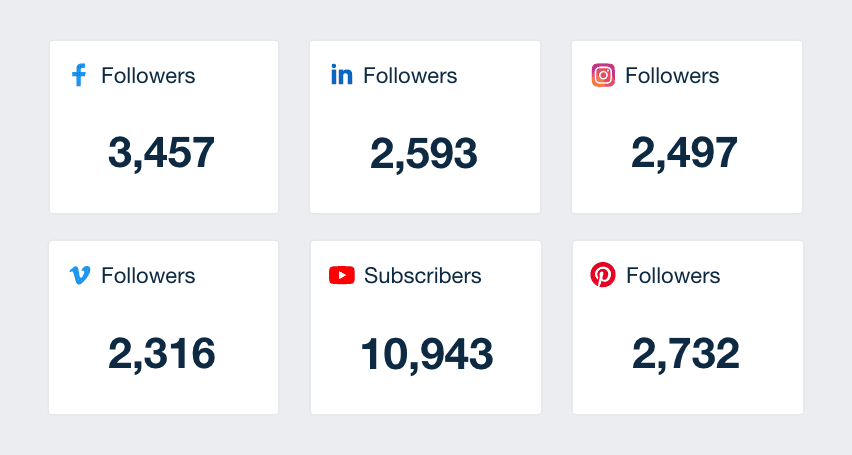
They may be able to come up with a relevant upselling strategy based on recurring requests or observations (e.g., upgrading a client’s retainer package to include additional social media graphics and more size options).
Just like that, you’ll uncover opportunities for account expansion and upsell successfully over time.
4 Common Upselling Challenges and How to Navigate Them
Your agency must be equipped with the right tactics to overcome common objections–let’s explore further.
Challenge | Solution |
|---|---|
Not enough agency resources | Assign work in-house, outsource, or onboard a new resource. Otherwise, politely say ‘no’ |
Client budget restraints | Explain the ROI of the upsell. Offer budget-friendly incentives without compromising your bottom line |
Client indecisiveness | Give your clients enough time to view your proposal thoroughly. Set a deadline to fast-track their response |
Client doesn’t see the benefit | Present ROI in a structured way. Use visual dashboards and reports to share compelling data insights |
Challenge #1: Your Agency Doesn’t Have Enough Resources
It’s one thing to pitch additional services but another to fulfill those client requests. The last thing you want is to get the green light for several upselling pitches without enough dedicated resources to handle the work.
The biggest challenge we face when upselling services to our clients is determining resource allocation. Time and money are both limited resources, and it's our responsibility to create the most impact for their bottom line. The process of resource allocation is (and should be) different for every client and heavily dependent on their business lifecycle stage and market position.
Kerrie Luginbill, Chief Strategy Officer at OTM
The Solution: Evaluate your staff’s workloads beforehand. Decide whether you’re assigning work in-house, outsourcing, or onboarding a new resource. Otherwise, don’t bite off more than you can chew.
By taking a realistic look at your roster, you’ll have a bird’s eye view of your agency’s bandwidth. That way, you’ll know if a few more tasks are feasible.

Streamline task management and create a rolling to-do list. Keep track of what your staff is working on and manage workflows more efficiently on AgencyAnalytics. Try it free for 14 days.
Challenge #2: Your Client Has Budget Constraints
It’s no secret that your clients are busy keeping their businesses afloat and trying to make lucrative decisions.
Even if your upselling recommendations are in the client’s best interest and they’re on board, sometimes there may be financial constraints.
Dealing with budget parameters is sometimes a challenge with upselling strategies. There may be opportunities that make a lot of sense from an ROI standpoint, but getting the investment can be challenging because marketing isn't an exact science, and no return is guaranteed.
Jeremy LaDuke, Founder at Epic Nine
The Solution: Explain the long-term ROI and come up with budget-friendly alternatives. At the same time, don’t severely compromise your agency pricing.
In these scenarios, remember to use your discretion to decide on the best way forward. Sometimes, a client doesn’t have the financial room to take additional services, and that’s okay too.
The times when we've succeeded generally are when we've had a strong relationship with a client and they have learned to trust our expertise.
Jeremy LaDuke, Founder at Epic Nine
Challenge #3: Your Client Can’t Make Up Their Mind
Your clients have a lot on their plates and are balancing countless priorities. It’s no surprise that they may sometimes stall on your upselling recommendations, internally debating whether the expenditure is worth it or falling into a pattern of endlessly weighing out multiple options.
The biggest internal challenge we face as a marketing agency is the infamous "waiting game". We often see our time-sensitive proposals expire because our clients can't make a decision or get out of their own way. The challenge with clients like this can be complex, especially when they're already doing business with you.
Jason Willis, Creative Director at Social Firm
The Solution: Understand the source of their indecision and reiterate your value proposition.
Oftentimes, clients may still be deciding because of other pressing priorities. In those instances, give them enough time to weigh their options and set a tentative follow-up date. That way, things won’t be up in the air.
On the other hand, perhaps they’re not 100% sold on what you’re proposing. Social proof–such as other clients’ success stories–will help to drive your message home and (hopefully) lead them to accept your upsell offer.
You don't want to come off as too aggressive or pushy, but you also don't want to let off the gas. If something will truly benefit your client and they just won't pull the trigger, don't let up. Instead of a direct follow-up email or call, send them social proof (such as analytics of other clients having success in this space) or articles that spell out the benefits of the services. These subtle reminders can help them to make a decision.
Jason Willis, Creative Director at Social Firm
Challenge #4: Your Client Doesn’t See the Benefits
Even the best upselling recommendation may be met with resistance if your client doesn’t understand the benefits.
Perhaps they’re content with your marketing services and don’t understand why you’re proposing additional services. On the other hand, they could see the benefit to some degree but aren’t convinced enough to act on your upsell offer.
Helping clients understand how to use data to grow and improve can be challenging, so we try to simplify how we present the data, what it means to the client, and where there are opportunities to grow their businesses and their ROI.
Barry Martin, President & Creative Director at The Idea Center
The Solution: Get clients on board by presenting ROI in a structured, systematic way.
Use a client reporting tool to filter existing data into visual dashboards, automate data retrieval, and provide compelling reasons for your upsell.
For example, even if your agency isn’t managing a client’s SEO efforts, the cost and effort to set up an automated SEO report is relatively small.

Read How To Prove Your Agency’s PPC ROI
If they don’t like the numbers they’re seeing, they will often end up asking if your agency also offers those services. That way, your clients will see the big picture of their marketing performance and understand your reasons for upselling.
As opposed to just throwing out suggestions, you need to show the client what the return is likely to be. It is vital the client understands what's in it for them when you make a recommendation and trust you to deliver based on past performance.
Matthew Taylor, Director at Common Ground
Boost Client Success and Fuel Your Agency's Growth Through Upselling
From providing added value to your clients to increasing your agency’s revenue, upselling is a win-win for everyone involved. To get the most from your upselling strategies, remember to:
Regularly check in with your clients and determine whether their needs have changed
Remain flexible and ease clients into more expensive packages if needed
Pitch relevant upsells that tie into business goals
Have a system in place to replicate upsell proposals and demonstrate ROI
With a reporting platform like AgencyAnalytics, you’ll have everything you need to showcase historical results and build a case for your upselling recommendations.
Create custom marketing dashboards, deliver data-rich reports, and show why your upsell is worth investing in.
Create a consistent reporting experience for your clients and increase your chances of upsell success. Explore the full range of time-saving features on AgencyAnalytics, free for 14 days.

Written by
Faryal Khan is a multidisciplinary creative with 10+ years of experience in marketing and communications. Drawing on her background in statistics and psychology, she fuses storytelling with data to craft narratives that both inform and inspire.
Read more posts by Faryal KhanSee how 7,000+ marketing agencies help clients win
Free 14-day trial. No credit card required.


